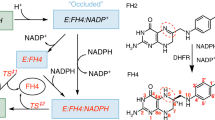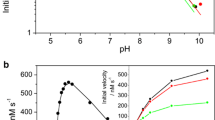Abstract
The thermodynamics of the methylenetetrahydrofolate reduction to 5-methyltetrahydrofolate was studied with the methylenetetrahydrofolate reductase purified from the homoacetogenic bacterium Peptostreptococcus productus. The equilibrium constants were determined for the forward and backward reactions of methylenetetrahydrofolate reduction with NADH or acetylpyridine adenine dinucleotide (APADH), respectively, as the electron donors. From the equilibrium constants and the known standard redox potentials at pH 7 (E o′) of the couples NAD+/NADH or APAD+/APADH the E o′ of the couple methylene-/methyltetrahydrofolate was determined to be about-200mV. This value is different from values reported before for this couple. The implications for the mechanism of energy conservation of homoacetogens is discussed.
Similar content being viewed by others
Abbreviations
- FH4 :
-
tetrahydrofolate
- CH2=FH4 :
-
5,10-methylenetrahydrofolate
- CH3-FH4 :
-
5-methyltetrahydrofolate
- K eq :
-
equilibrium constant
- ΔG o :
-
Gibb's free energy change under standard conditions (all concentrations of reactants = 1 M)
- ΔG o′ :
-
ΔG o at pH 7 ([H+]=10-7 M)
- E o :
-
standard redox potential
- ΔG o :
-
standard redox potential difference of two reactants
- ΔE o′ :
-
ΔE o at pH 7
- R :
-
gas constant
- F :
-
Faraday constant
- APAD:
-
acetylpyridine adenine dinucleotide (NAD+-analogue)
References
Bergmeyer HU (1988) Methods of enzymatic analysis, vol II, 3rd edn. Verlag Chemie, Weinheim, p 369
Diekert G, Schrader E, Harder W (1986) Energetics of CO formation and CO oxidation in cell suspensions of Acetobacterium woodii. Arch Microbiol 144: 386–392
Fuchs G (1986) CO2 fixation in acetogenic bacteria: variations on a theme. FEMS Microbiol Rev 39: 181–213
Geerligs G, Schönheit P, Diekert G (1989) Sodium dependent acetate formation from CO2 in Peptostreptococcus productus (strain Marburg). FEMS Microbiol Lett 57: 253–258
Heise R, Müller V, Gottschalk G (1989) Sodium dependence of acetate formation by the acetogenic bacterium Acetobacterium woodii. J Bacteriol 171: 5473–5478
Kaplan NO, Ciotti MM, Stolzenbach FE (1956) Reaction of pyridine nucleotide analogues with dehydrogenases. J Biol Chem 221: 833–844
Katzen HM, Buchanan JM (1965) Enzymatic synthesis of the methyl group of methionine. VIII. Repression-derepression, purification, and properties of 5,10-methylenetetrahydrofolate reductase from Escherichia coli. J Biol Chem 240: 825–835
Keltjens JT, van der Drift C (1986) Electron transfer reactions in methanogens. FEMS Microbiol Rev 39: 259–303
Tschech A, Pfennig N (1984) Growth yield increase linked to caffeate reduction in Acetobacterium woodii. Arch Microbiol 137: 163–167
Uyeda K, Rabinowitz JC (1967) Enzymes of clostridial purine fermentation. Methylenetetrahydrofolate dehydrogenase. J Biol Chem 242: 4378–4385
Wohlfarth G, Geerligs G, Diekert G (1990) Purification and properties of a NADH dependent 5,10-methylenetetrahydrofolate reductase from Peptostreptococcus productus. Eur J Biochem 192: 411–417
Author information
Authors and Affiliations
Rights and permissions
About this article
Cite this article
Wohlfarth, G., Diekert, G. Thermodynamics of methylenetetrahydrofolate reduction to methyltetrahydrofolate and its implications for the energy metabolism of homoacetogenic bacteria. Arch. Microbiol. 155, 378–381 (1991). https://doi.org/10.1007/BF00243458
Received:
Accepted:
Issue Date:
DOI: https://doi.org/10.1007/BF00243458




